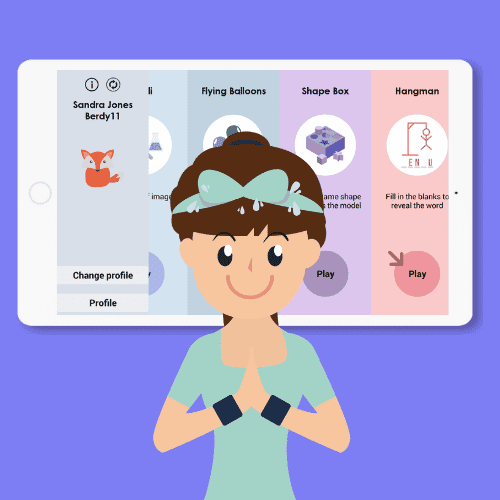Sensory stimulation is an effective approach to promoting cognitive and emotional stimulation in elderly people in retirement homes. By using specific sensory activities, it is possible to stimulate memories, improve quality of life and encourage residents’ involvement. In this article, we explore the different sensory activities that can be set up in nursing homes to stimulate the memories of the elderly. We’ll also look at the benefits of sensory stimulation and provide practical advice on how to integrate these activities into residents’ daily lives.
Sensory activities to stimulate memories in the elderly
Sensory activities offer invaluable benefits for stimulating memories in elderly people in retirement homes. By using appropriate sensory stimuli, such as smells, music, touch and artistic activities, it is possible to evoke memories, encourage engagement and improve residents’ quality of life. It is essential to integrate these activities into residents’ daily lives, planning them on a regular basis and adapting them to individual needs and preferences. Sensory activities offer a valuable opportunity to create meaningful moments and enhance the emotional and cognitive well-being of elderly people in retirement homes.
There are many sensory activities that can be set up in retirement homes to stimulate residents’ memories. Here are some examples:
1. Smells and memories
Smell is a powerful sense linked to memories and emotions. Offering aromatherapy or scent workshops where residents can smell familiar scents such as lavender, coffee, vanilla or pine can evoke memories and encourage exchanges between residents.
As a psychologist working in a nursing home, I’ve had the privilege of witnessing time and again the extraordinary power of the senses in awakening memories and stimulating emotions in our residents. Among the various activities we offer to promote their well-being, scent-based sensory exploration has emerged as one of the most deeply rewarding.
Every day, I strive to create an environment conducive to the emotional fulfillment of our seniors. More than just a scent, odors are a gateway to a past rich in experience and emotion. I have fond memories of Mrs. Dupont, a discreet, introverted resident who had gradually lost the thread of her memory. During a sensory session where I’d brought along a small bottle of lavender, her eyes lit up with a familiar glow. She told me how she loved to cultivate lavender fields in her youth, in the South of France. The details she shared were precise and colorful, as if the simple scent had opened a window to her past memories.
Another memorable moment was shared with Mr. Martin, a former sailor. When I brought a box containing various marine scents – salt, seaweed, and light notes of fish – his wrinkled face lit up. He told me incredible stories of sea voyages, storms and camaraderie. These tales were accompanied by a mixture of smells that really seemed to transport him back in time.
Smells are powerful triggers for imagination and memories. They transcend the barriers of language and cognition, touching the soul directly. Cinnamon may evoke joyous moments in the family kitchen, while the smell of rain may transport some residents to childhood afternoons spent jumping in puddles.
That’s why I’ve integrated these sensory activities into our routine at our nursing home. Every week, we organize sessions where residents can smell, touch and sometimes even taste various substances and objects that evoke memories. The resulting discussions create a bond between residents and also facilitate intergenerational conversations with staff and visitors.
Working with smells and memories at our nursing home is an emotionally enriching experience. Every smile, every story shared, every expression of joy or melancholy is proof of the timeless power of the senses in shaping our identity and our life experiences.
2. Music and memory
Music is a powerful memory stimulator for the elderly. Organizing listening sessions to popular songs and music from their youth can revive memories and encourage residents to share their experiences of these songs. Dance can also be integrated for a complete sensory experience.
I’m a speech therapist in a nursing home, and I’ve discovered a hidden treasure in music. Music’s incredible ability to evoke deep memories and weave emotional bonds has always fascinated me. As part of my work, I’ve had the opportunity to see how melodies from the past have the power to revive memories and bring joy to our elders.
During our sessions, I regularly incorporate special musical moments, where residents are invited to listen to songs that resonate with their past. It’s amazing how tired faces suddenly come alive at the sound of a familiar melody. A poignant example is Mme Dubois, a former cabaret singer. As she struggles to remember the details of the present, the songs of her era allow her to relive moments of glory and share colorful anecdotes from her life on stage.
Music also has the power to stir deep emotions. Mr Renaud, once a renowned pianist, is no longer able to play due to advanced dementia. However, when I brought her a gentle melody on the piano, her fingers made familiar movements on her lap. His eyes filled with tears, and his daughter confided in me that this song was the one he always played for her when she was a child. The music had succeeded in opening a window to the past, allowing Mr. Renaud to reconnect briefly with his role as father and musician.
Music is also a gateway to social interaction. During our “musical workshops”, residents sing, tap their feet and sometimes even dance. This creates a sense of community and shared emotions, transcending the barriers of illness and isolation.
Musical sessions have proven their ability to soothe and reassure. Soft music playing in the background creates a calm atmosphere, ideal for moments of relaxation and meditation.
Every note played, every chorus sung, every smile brightened by the melody is tangible proof of the power of music on the memory and emotions of our residents. As a speech therapist, I’ll continue to explore these melodies of the past to shed light on our elders’ present.
3. Tactile exploration
Tactile activities, such as handling different textures, can stimulate the senses and encourage memories. Make objects such as soft fabrics, shells, rough materials or feathers available for residents to touch and explore.
As an occupational therapist working in a nursing home, I have witnessed the wonderful results of tactile exploration in improving the quality of life of our residents. The simple act of manipulating various textures and engaging in tactile activities offers much more than sensory pleasure: it creates deep, meaningful bonds between individuals, even when words become scarce.
When I started introducing tactile activities into my sessions with residents, I was amazed at how it unlocked channels of communication that had previously seemed closed. Take the example of Mr. Dupuis, a once eloquent man who lost the ability to express himself following a stroke. By offering him a range of objects with different textures – from soft velvet to the roughness of tree bark – I observed an astonishing transformation. Tactile sensations seemed to revive emotional memories, and his hands spoke where words failed. As he caressed the velvet surface, he let out tears of joy, while as he touched the bark, a melancholy smile spread across his face.
What’s more, tactile exploration can also create meaningful moments of connection between residents and their loved ones. I was lucky enough to attend a session with Ms. Lévesque and her granddaughter. Mrs Lévesque, who suffered from advanced dementia, had difficulty recognizing family members. Offering her a series of familiar objects – a scarf knitted by her granddaughter, an old pocket watch from her husband – her granddaughter gently guided her grandmother’s hands over them, eliciting moments of intimacy and shared emotion.
These tactile activities also have a calming and relaxing effect, helping to reduce anxiety and agitation. The experience of holding and manipulating familiar or comfortable objects creates a sense of security and familiarity.
As part of our regular sessions, I have integrated tactile exploration as an essential means of engaging residents in social and emotional interactions. Touch becomes a universal form of communication, a way of connecting across cognitive and verbal barriers. Every gentle touch, every shared smile, every moment of silent understanding is tangible proof of the power of human contact.
4. Artistic activities
Artistic activities, such as painting, drawing, pottery or collage-making, can be creative ways of stimulating residents’ senses and memories. Encourage them to express themselves artistically, using bright colors, varied materials and subjects that evoke memories.
As a passionate entertainer working in the heart of a nursing home, I’ve witnessed a real transformation when our residents get involved in artistic activities. Painting, pottery, collage and many other workshops have the magic of releasing buried creativity and creating moments of joy and connection that enrich the lives of our seniors.
When I organize art workshops, I can feel a particular energy in the room. Residents, often reserved at first, become fully engaged in exploring colors, shapes and textures. Take Mrs Boucher, a former seamstress who joined our collage workshop. By manipulating fabrics, colored papers and accessories, she created a magnificent collage that told the story of her own journey through time, incorporating pieces of fabric from garments she had made in the past. Artistic activities thus become a means of expressing and sharing one’s unique story.
These artistic workshops also have the power to create intergenerational links. By inviting young local artists to participate, we give residents the opportunity to pass on their knowledge and experience. These moments of exchange are invaluable, building bridges between generations and reinforcing the sense of belonging to a community.
Beyond creativity, artistic activities bring a deep sense of calm. When our residents immerse themselves in painting, pottery or collage, their worries seem to evaporate, giving way to a peaceful concentration on the present moment.
The end result is not always the main objective. What counts is the creative process itself, the journey each resident undertakes through colors, shapes and materials. The beaming smiles that light up their faces as their creations come to life under their hands are the real rewards.
Every brushstroke, every piece of glued fabric, every moment of contemplation in front of a finished work is tangible proof of the power of artistic activities to bring joy, creativity and connection to the days of our beloved residents.
The benefits of sensory stimulation in nursing homes
Sensory stimulation offers many benefits for elderly people in retirement homes, particularly in terms of stimulating memories and general well-being. Here are some of the main benefits:
1. Memory stimulation
Sensory activities, such as the use of familiar smells, music, textures and colors, can evoke memories and emotions in the elderly. These sensory stimuli can revive buried memories and encourage exchanges and discussions between residents.
2. Improved mood and engagement
Sensory activities create pleasant and stimulating experiences, which can improve the mood and engagement of nursing home residents. Exploring different textures, listening to favorite music or smelling familiar scents can arouse positive emotions and strengthen the bond between residents and their environment.

3. Reduced stress and anxiety
Sensory stimulation can also help reduce stress and anxiety in elderly people living in retirement homes. Soothing sensory activities, such as guided relaxation, gentle massages or listening to relaxing sounds, can promote a state of calm and relaxation, improving residents’ emotional well-being.
4. Improved cognitive skills
Sensory activities call on various cognitive abilities, such as attention, memory and perception. Engaging in stimulating sensory activities can help maintain and enhance cognitive function in the elderly. For example, sensory games based on the recognition of smells or textures can train memory and concentration.
Tips for integrating sensory activities into residents’ daily lives
To effectively integrate sensory activities into the daily lives of nursing home residents, here are a few practical tips:
Planning: Establish a regular schedule of sensory activities and make sure you integrate them into the retirement home’s activity program. Set aside time for sensory stimulation to enable residents to participate on a regular basis.
Adaptation: Take into account residents’ individual abilities and preferences when choosing sensory activities. Adapt activities to each resident’s physical, sensory or cognitive limitations to ensure active participation and enjoyment.
Supportive environment: Create a suitable environment for sensory activities, using elements such as soothing colors, appropriate lighting and a calm ambience. Make sure the spaces you use are comfortable and safe for residents.
Professional supervision: enlist the help of qualified professionals, such as occupational therapists or specialized animators, to plan and lead sensory activities. Their expertise can help maximize residents’ benefits and safety.
Observation and adaptation: Carefully observe residents’ reactions to sensory activities. Be alert to signs of pleasure, engagement or distress, and adapt activities accordingly to meet the specific needs of each resident.
Turnkey digital sensory activities
The integration of digital sensory activities into nursing homes activity programs has revealed surprising benefits. These modern experiences offer a new dimension to our residents, allowing them to stimulate their senses in innovative ways. Through captivating photos and videos, memories are revived, transporting our elders back in time. Interactive games that challenge the memory provide fun challenges while boosting cognitive skills. Digital sensory activities are real gateways to a variety of worlds, bringing renewed vitality to our residents and opening up enriching opportunities for social interaction. Using technology as a sensory tool broadens the horizons of our residents, contributing to their physical and mental well-being in new and exciting ways.
Discover 3 apps, CLINT, SCARLETT, and E-MEMORIES, which you can test for free by downloading them.
CLINT
More than 30 cognitive games for independent seniors, with many cultural games for fun reminiscence workshops (Quiz, recipes, geography, … )

SCARLETT
The same games, but easier, for people suffering from dementia or Alzheimer’s disease. Recalling memories has a very positive impact.

E-MEMORIES
The E-Memories app presents images, videos and audio clips, with music from the 1930s to the present day, for their enjoyment!

COMING SOON
Other articles that might interest you:
The Role of Cognitive Apps in Speech Therapy for Alzheimer’s Patients
Alzheimer’s disease is a progressive neurological disorder that primarily affects memory, thinking, and behavior. As...
Memory Apps for Alzheimer’s: Enhancing Recall in Speech Therapy Sessions
Alzheimer's disease is a progressive neurological disorder that primarily affects memory, thinking, and behavior. As...
Cognitive Rehabilitation Apps for Speech Therapy with Alzheimer’s Patients
In recent years, the landscape of cognitive rehabilitation has evolved significantly, largely due to the advent of...







